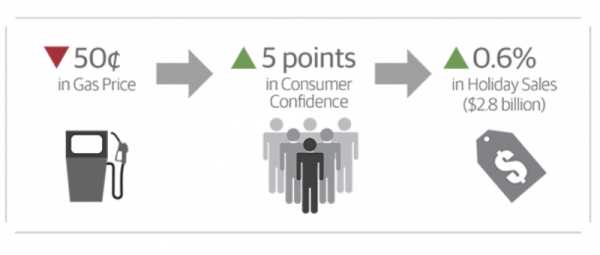The price of oil is the overriding economic theme at the moment. Oil prices have declined to their lowest level in more than four years and I believe they could continue to tumble. The market implications are positive in the near term, but there is a dark side to the decline in oil prices that is beginning to negatively impact a number of countries around the world and which could ultimately come home to roost in the United States.
First, the positive: falling oil prices and the subsequent decline in gasoline prices act like a tax cut, transferring cash into the pockets of consumers, leaving more money for discretionary spending. The combined benefit of declining gas prices and lower interest rates is likely to provide American consumers, and subsequently the U.S. economy, with a boost as we head into the all-important holiday shopping season.
The darker side to falling oil prices is that they signal that the global economy isn’t growing fast enough to absorb the growth in oil production. The slump in oil prices has led to a weakening in the currencies of some major oil-exporting nations. Russia, for example, has witnessed a 24 percent decline in the value of the ruble against the dollar since the beginning of November. Russia needs oil at $100 a barrel to support its economy, and many other oil-dependent economies rely on oil prices well north of current levels. Over time, as foreign currency reserves run dry, the likelihood is that we will see economic contraction and possibly recession in these countries.
A recession in countries such as Russia will have significant knock-on effects, particularly for European exporters, creating another headwind for beleaguered euro zone economies. An oil-price-induced negative feedback loop would stifle global growth and could even lead to political instability in any number of oil-dependent nations.
Beginning as early as the first quarter of 2015, investors should be wary of the potential for a setback in U.S. equities as the adverse impacts of lower growth and weaker foreign currencies begin to show through in the results of leading multinational companies.
In Europe, it doesn’t seem likely the European Central Bank is going to be able to reach the necessary consensus to begin quantitative easing through the purchasing of sovereign debt until the end of the first quarter or possibly into the second quarter, and perhaps never. ECB President Mario Draghi is running into roadblocks with the German Bundesbank over the sovereign bond-buying option, which will probably end up in the European courts. The problem is, the longer this situation drags on, the worse the situation in Europe is going to get. The clock is ticking and policymakers are running out of time.
One option the ECB still has left is to buy gold. If European inflation data comes in weaker and the European economy continues to sputter, I think we could see the ECB consider gold purchases, but if we do it will be an act of desperation. Gold may prove the ultimate hedge against a financial crisis in Europe should the ECB fail to act quickly.
The Bright Side: Cheaper Gas, Rising Consumer Confidence Should Boost U.S. Holiday Spending
Despite the drop in consumer spending during the Black Friday weekend, the outlook for consumption remains solid heading into the holiday shopping season. Historically, Black Friday sales have had little predictive value for total holiday season sales. A more important relationship is between gasoline prices and consumer confidence, and then between consumer confidence and holiday sales. With gas prices at their lowest levels since 2010, consumer confidence has jumped to seven-year highs, and higher consumer confidence predicts higher holiday sales. Increased consumer confidence, combined with additional discretionary income freed up by falling gas prices, should provide a boost to economic growth in the fourth quarter.
Gas Prices and Consumer Confidence

Source: Bloomberg, Haver, Guggenheim Investments. Data as of 11/28/2014. Note on methodology: The estimated change in consumer confidence is based on monthly retail gasoline prices and University of Michigan consumer confidence. The holiday sales estimate is based on the average reading of the University of Michigan consumer confidence index in November and December and retail sales excluding autos, gas, and building materials in November and December. All data since 1994.
This material is distributed for informational purposes only and should not be considered as investing advice or a recommendation of any particular security, strategy or investment product. This article contains opinions of the author but not necessarily those of Guggenheim Partners or its subsidiaries. The author’s opinions are subject to change without notice. Forward looking statements, estimates, and certain information contained herein are based upon proprietary and non-proprietary research and other sources. Information contained herein has been obtained from sources believed to be reliable, but are not assured as to accuracy. No part of this article may be reproduced in any form, or referred to in any other publication, without express written permission of Guggenheim Partners, LLC. ©2014, Guggenheim Partners. Past performance is not indicative of future results. There is neither representation nor warranty as to the current accuracy of, nor liability for, decisions based on such information. Past performance is not indicative of future results. There is neither representation nor warranty as to the current accuracy of, nor liability for, decisions based on such information.
Scott Minerd is Chairman of Investments and Global Chief Investment Officer at Guggenheim Partners

